1000
Asia Pacific J Clin Nutr (1997) 6(3): 214-218
Asia Pacific J Clin
Nutr (1997) 6(3): 214-218

Macronutrient
intake of elderly people in the Padang area,
West Sumatra, Indonesia
Masatoshi Nakano* PhD, Fadil Oenzil3
MD, PhD,
Yoshiko Itoh* BHomeEc, Toshiaki Mizuno*
BS, Yukio Saitoh1 MD, PhD, Shigeo Kondo2
PhD, Hafni Bakhtiar3 MD, Indrawati Lipeto3
MD and Zulkanine Agus3
MD
Department of Public Health1,
Department of Parasitology2, Institute for
Medical Science of Aging*, Aichi Medical University, Nagakute-cho,
Aichi-ken 480-11, Japan.
Faculty of Medicine3, Andaras University,
Padang, West Sumatra, Indonesia.
We examined the macronutrient intake of residents
in Padang area, West Sumatra, Indonesia. The daily energy intake
(1130±420 kcal) of elderly people in a rural traditional group was
significantly lower than that in an urbanised "modernised"
group (1700±460 kcal) (p<0.01). Even in young urbanised people
(younger than 60 years old), 44.2% were below 2000 kcal per day.
In the case of elderly people, in rural and urbanised groups 90%,
and 33% of the respondents were below 1500 kcal per day, respectively.
As for individual nutrients, the daily protein intake
of elderly people in both the urbanised and rural groups was rather
low. However, daily fat intake and carbohydrate intake of the younger
people in the urbanised group were adequate, but those in the elderly
group were not. In the case of the rural elderly group, macronutrient
and energy intake were extremely low. To improve dietary habits
and nutrient intakes of people in the Padang area, rural elderly
people need a greater energy intake and an increased intake of all
macronutrients.
Key Words: Nutrients, elderly people,
epidemiological study, Padang, West Sumatra, Indonesia
Introduction
Several physiological functions and body composition
decrease with age1-3. Nutritional status greatly affects
the aging process beginning at sexual maturation4-7. The
free radical theory is one of the important theories about the mechanism
of aging8. Antioxidant defence 1000 systems decrease with
age, but the decrease is found to differ by tissue9,10.
Dietary (energy) restriction and dietary antioxidants may suppress
the aging process11-13; although the operational relevance
of this extrapolation for energy restriction to humans lacks evidence,
and the reverse may be the case in physically active individuals on
nutritious diets19. The precise mechanisms of any action
of dietary antioxidants to slow ageing is not known.
Recently, remarkable changes in life style and food
habits are occurring in the urban area of Padang in West Sumatra,
Indonesia. In west Sumatra coconut oil is commonly used in cooking,
because it is readily available14. Furthermore, there are
some traditional fatty dishes in the Padang area. One famous dish
is a "Soto Padang" containing a great deal of coconut oil,
chicken, rice, and vegetables. Dietary fat consumption in West Sumatra
is increased gradually, because of the additional consumption of dairy
fat and meat, such as beef and chicken, in addition to coconut oil
and coconut milk. Changes in cooking styles also may have led to an
increase in dietary fat intake. Thus, it is worth studying the differences
between a group with a modernised life style and a group with a traditional
life style.
There is little doubt that an adequate nutrient intake
should be achieved to prevent poor nutritional status, which in people
leads to a decline in health. The Indonesian Food and Nutrition Board
has recommended that energy intake per day for adults should be of
the order of 2500 kcal (595kj) and 50 g per day of protein. In general.
If energy and protein intakes are adequate and the diet is varied,
nutrient and biologically important food component intakes at large
will be adequate.
In the present study daily intake of energy and macro-nutrients
has been quantified and the difference in intakes between young and
old residents in the Padang area aged from 20 years to 93 years assumed.
If the nutritional quality of intake declines with age, this may contribute
to ageing, as well as result from it.
Subjects
and methods
Subjects
Subjects were administrative staff of the Faculty
of Medicine, Andaras University, and their family members, aged 20
to 85 years, living in the Padang area of West Sumatra as an advantaged
urbanised group (urban group; n=119). Other elderly people (60 to
93 years old) were selected by a random sampling technique from all
people in Kelurahan Olo Kecamantan Nanggalo as a group with rural
dietary habits (rural group; n=50) (men = 16, women =34).
Nutrient
intakes and food habits
Dietary data were collected by 24-hour recall. Nutrient
conversion was undertaken using the Indonesian Food Composition Tables.
The interviews were conducted by trained personnel using household
measures to estimate portion size.
Health
status
Respondents had a general medical assessment with
record of blood pressure, urinanalysis, underwent electrocardiography.
Statistics
Statistical analysis was performed with ANOVA followed
by Scheffe’s or Bonferroni/ Dunn’s multiple comparison test.
Differences between the two groups of the younger respondents, the
aged respondents of the modernised group, and the aged respondents
of the rural group were performed with Student’s t-test.
Results
Health status of the respondents was good. As for
electrocardiogram 4 respondents had left ventricular hypertrophy (LVH),
and 2 respondents had supraventricular extrasystole. Urinanalysis
showed that 2.5% (3/119) of respondents were blood positive and 0.8%
(1/119) glucose positive, and had proteinuria or bilirubinuria in
their urine. As shown in Table 1, some were hypertensive, defined
as a persistent blood pressure of 160 mm Hg systolic or 100 mm Hg
diastolic or greater, in both arms. Hypertension prevalence was much
higher in elderly people (20% in the urbanised group and 24% in the
rural group) than in the younger group (4.8%).
Table 1. Blood pressure of residents in the
Padang area.
| |
Urbanised Young (n=104)
|
Urbanised Aged (n=15)
|
Rural Aged (n=50)
|
| Age men/women |
37.5±11.2
|
64.7±7.08
|
71.0±8.36
|
| Height |
154±7.48
|
150±7.19
|
151±7.17
|
| BMI (kg/m2) |
22.6± 4.26
|
19.8± 3.16
|
19.4± 3.62
|
| Body weight |
53.8±10.2
|
44.6±9.0
|
44.8±9.54
|
| Systolic BP, mmHg |
122±13.1
|
139±21.8
|
141±16.0
|
| Diastolic BP, mmHg |
74±11.3
|
76.3±12.0
|
85.7±8.98< 1000 /font>
|
| Hypertension (%) |
4.8 (5/104)
|
20 (3/15)
|
24 (12/50)
|
As can be seen in Table 2, the average daily energy
intake and daily intake of main nutrients such as protein, carbohydrate
and fat were significantly different between the urbanised group and
the rural group. The daily energy intake (1130±420 kcal) in the elderly
rural group was significantly lower than that in the elderly urbanised
group (1700±460 kcal) (p<0.01). Many respondents (44.2%) were below
2000 kcal per day in the younger urbanised group. In the elderly rural
and urban groups 90% and 33% of the respondents were below 1500 kcal
per day, respectively. This, however, was not reflected in BMI (Body
Mass Index); 46 to 47% of the respondents in both groups had a BMI
of less than 19 kg/m2.The BMIs of aged people in both rural
and urbanised groups were smaller than those of younger people of
the urbanised group (p<0.01) (Table 1). The macronutrient intakes
of elderly people in the rural group were less than those of the urbanised
groups, although percentage energy was limited. Young respondents
(20 to 60 years old) of the urbanised group had relatively higher
intakes of total dietary protein, fat and carbohydrate. The average
daily protein intake of young respondents in the urbanised group was
55.4 g, of which 27.1 g was animal protein (48.9% of total protein).
(Table 2).
Table 2. Daily intake of energy and main nutrients
of residents in the Padang area.
| |
Urbanised group young
(n=104)
|
Urbanised group aged
(n=15)
|
Rural group aged
(n=50)
|
| Energy (kcal/day) |
2120±517
|
1700±460
|
1130±420
|
| Protein (g/day)
Animal protein (g/day)
|
55.4±18.3 (10.5)
27.1±19.6 (5.1)
|
42.8±13.9 (10.1)
22.9± 8.9 (5.4)
|
38.2±22.7 (13.5)
17.1±13.9 (6.1)
|
| Carbohydrate (g/day) |
351 ±102 (66.2)
|
288 ±69.5 (67.8)
|
187 ±79.3** (66.2)
|
| Fat (g/day) |
51.2±21.5 (21.7)
|
38.9±22.4 (20.6)
|
25.7±12.2** (20.5)
|
1. Values show mean±SD, Significant difference between
urban and rural; 2. Percentage energy intake is shown in parentheses.
* p<0.05, ** p<0.01.
As shown in Figure 1, the energy intake of respondents
in the 30-40 year old group was the highest of all the sectors of
the urbanised group. Energy intake in the elderly group (>60s)
and the younger group (20s) was significantly lower than that in the
highest group (30-40s) (p<0.01), and the 60-year age group was
lower than the 50-year age group (p<0.05). Body mass index (BMI)
showed similar differences to those for energy intakes (p<0.05).
Figure 1A. Daily energy intake and BMI of residents
in Padang area. A: daily energy intake, B: BMI (kg/m2).
Data show mean±SD. Significant difference; *
p<0.05, ** p<0.01.
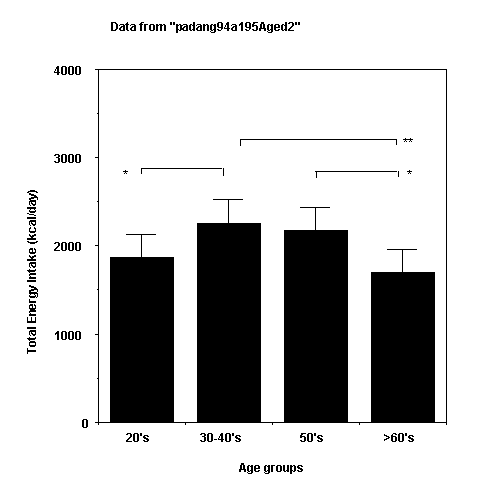
Figure 1B.
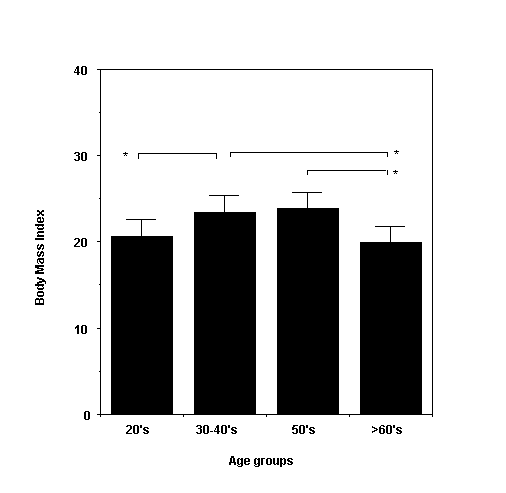
As can be seen in Figure 2, carbohydrate intake in
the elderly group (>60s) and the younger group (20s) was significantly
lower than that in the group of 30-40s (p<0.05). People in the
Padang area consumed relatively high amounts of carbohydrate. In the
elderly people, 36% of the rural group and 50% of the urbanised group
consumed more than 200 g of carbohydrate per day. In the case of all
the respondents in the urbanised group, 53.3% consumed more than 300
g per day, and 91.5 % of the respondents consumed 200g per day.
Figure 2. Distribution of daily intake of carbohydrate
of residents in the Padang area. Data show mean ± SD. Significant difference; * p<0.05.
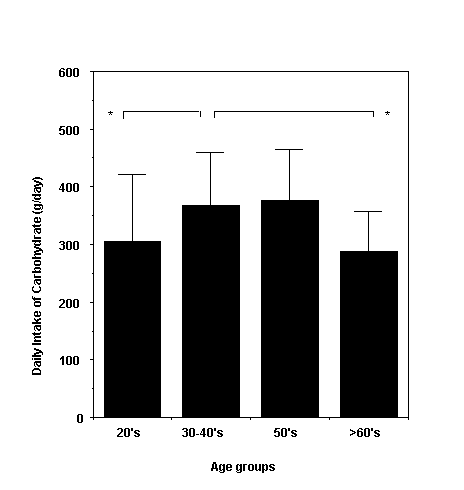
As can be seen in Figure 3, daily protein intake in
the aged (>60s) and the younger group (20s) was significantly lower
than that in the middle-age group (30-40s). The daily intake of animal
proteins in elderly people of both the urbanised groups (22.9± 8.9
g/day) and the rural group (17.1±13.9 g/day) was low.
Figure 3. Daily protein intake of residents
in the Padang area; total protein intake; animal protein intake. Data
show mean ± SD. Significant difference; * p<0.05.
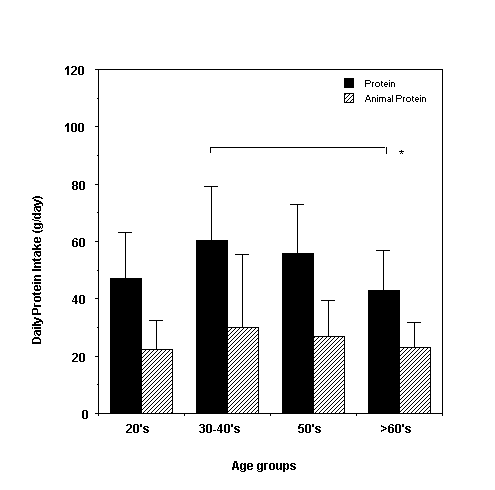
Respondents who consumed more than 50 g fat per day
were 4% and 39.4% of the aged respondents in the rural elderly group
and in the urbanised elderly group, respectively. In the case of all
respondents in the urbanised group, 53.3% consumed more than 50g per
day. As shown in Figure 4, daily intake of fat in the aged group (>60s)
was significantly lower than that in the middle-age group (30-40s)
(p<0.05). As for individual types of fat, respondents in the urbanised
group had relatively high intakes of coconut oil and coconut milk,
which accounted for 12% of total energy.
Figure 4. Daily fat intake of residents in
the 1000 Padang area. Data show mean±SD. Significant difference; *
p<0.05.
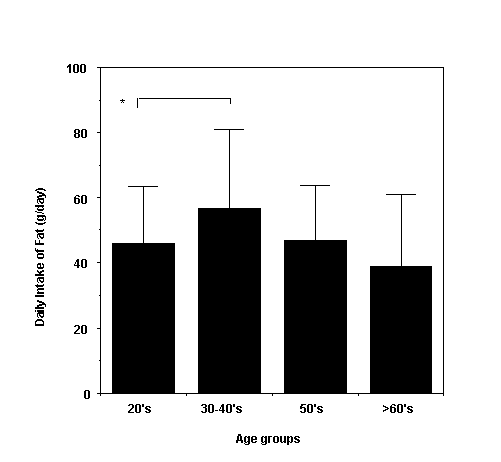
Discussion
We conducted an epidemiological study of the energy
and macro-nutrient status of residents in the Padang area of West
Sumatra. We chose an area where people lived either a traditional
rural life-style or an urbanised life style. The Indonesian Food and
Nutrition Board has recommended that energy intake and protein intake
per day should be about2500 kcal and 50 g, respectively. The recommended
value of energy intake for elderly people (>60 years old) is 2100
kcal/day for men, and 1710 kcal/day for women. Fat intake is recommended
to be 20-25% of total energy. As shown in Table 2, the daily energy
intake of the elderly people in the rural group was significantly
lower (1130 kcal/day) than that in the urbanised group (1700 kcal/day).
Even so both are lower than recommended values. People in the Padang
area acquired most of their energy (66%) from carbohydrates. Daily
protein intake in the urbanised young group was 55.4 g of which 27.1
g (48.9% of total protein) was animal protein. It is thought preferable
that, animal protein constitute more than 50% of total protein. The
protein intake of elderly people in the urbanised group (42.8 g/day)
has almost reached the recommended value (49 g/day for men and 41
g/day for women), but this is not the case in the rural group (38.2
g/day). In the case of dietary fat, young respondents in the urbanised
group took 51.2±21.5 g/day which is 21.7% of total energy. In the
case of elderly people in both the urbanised group and the rural group,
dietary fat was 20.5% of total energy. These values reached the recommended
value. Interestingly, about 12-13% of total energy was from coconut
oil and coconut milk. A high intake of coconut oil and coconut milk
is rather special in world nutrition, but common in tropical countries.
Coconut oil is composed of 9% unsaturated fatty acid and 91% saturated
fatty acid. The saturated fatty acid in coconut oil contains 47% lauric
acid, (12:0) 18% myristic acid (14:0), 9% palmitic acid (16:0), 8%
octanoic acid (8:0), 6% decanoic acid (10:0), and 3% stearic acid
(16:0). Thus coconut oil contains high amounts of middle- length saturated
fatty acids.
As can be seen in Figures 1-3, the middle-age group
(40s-50s) had the highest energy and macronutrient intake of all the
age groups. The younger group (20s) had a relatively low intake of
macronutrients. This may be associated with income. Alcohol is a macronutrient
which provides energy. However, most people in Padang, West Sumatra,
do not drink alcohol at all, for religious reasons. The non alcohol
derived energy intakes for nutrients in various countries are shown
in Table 3.
Table 3. Percent energy from food macronutrients
in several countries.
| Country |
Total energy (kcal)
|
Protein (%)
|
Fat (%)
|
Carbohydrate (%)
|
| USA. |
3,500
|
12 1000 .3
|
45.4
|
42.3
|
| Germany |
3,540
|
11.5
|
48.1
|
40.4
|
| France |
3,490
|
13.9
|
46.0
|
40.0
|
| Switzerland |
3,440
|
12.3
|
43.6
|
44.1
|
| Japan |
2,640
|
13.3
|
28.4
|
58.2
|
| Indonesia (this paper) |
2,120
|
10.4
|
21.7
|
66.2
|
West Sumatra has the highest coronary mortality in
Indonesia14. Coronary mortality in the whole Indonesia
is the third highest cause of mortality after respiratory infection
and diarrhoea. Thus, the prevention of coronary disease is of great
importance. Hypertension is one of the risk factors for coronary heart
disease, and the prevalence of hypertension in elderly people in the
Padang area was 20-24% (Table 1). Ischaemic heart disease (IHD) is
strongly related to life style. Examples of potentially harmful life
style elements of aetiological importance for IHD include a high amount
of saturated fat in the diet, tobacco smoking, and low physical activity.
Iacono et al15 reported that a high intake of saturated
fatty acids and a low intake of polyunsaturated fatty acids were related
to high blood pressure, but total fat intake did not relate to blood
pressure levels. It is estimated that many Americans consume 15% to
20% of their energy intake as saturated fatty acids16.
The major food sources and contributo 1000 rs of saturated fatty acids
in United States’ diets are meats, poultry, fish, milk, cheese,
butter, and eggs (70% to 75%)16. Trevisan et al17
reported a cross-sectional association between the consumption of
various fats and the risk factors for coronary heart disease in a
sample of 4903 Italian men and women from 20 to 59 years of age. According
to their analysis, consumption of butter may detrimentally affect
coronary risk factors, while polyunsaturated and monounsaturated fats
may be associated with a lower coronary risk profile. Diet plays an
important role in the aetiology of coronary heart disease18,19.
A high intake of soluble dietary fibre decreases low
density lipoprotein cholesterol, but has little or no effect on high
density lipoprotein cholesterol20,21. Rimm et al22
reported that fibre is an important dietary component for the prevention
of coronary heart disease, possibly through mechanisms other than
through lipoproteins. People in the Padang area consume a great deal
of coconut oil and coconut milk which has a high saturated fat content,
even in the urbanised group. Moreover, a high percentage (about 60%)
of Indonesian people smoke cigarettes. Thus, high coronary mortality
may be due to a high intake of saturated fats and/or cigarette smoking,
and also may be other factors of life-style. At the same time, the
cardio-protective fretons which may accompany high intakes of plant
food and fish require appreciation.
Beverage intake (tea and coffee) may also be important.
Whether or not coffee consumption increases the risk of coronary heart
disease has been examined in many studies23. Coffee is
a pungent beverage including polyphenolic substances and diterpenes,
the latter of which unfavourably affect lipoproteins24.
People in the Padang area use many spices which contain a number of
polyphenolic substances. It may be of value to consider changing consumption
of spices as a potential protective factor against coronary heart
disease.
References
- Strehler BL. Time, Cells and Aging (2nd ed.) New
York: Academic Press 1977.
- Nakano M. When aging begins. Kagaku to Seibutsu
(Chem. & Biol.) 1989; 27: 189- 194 (in Japanese).
- Nakano M. Longevity and Aging in Mammals. In Hayakawa
K ed. Longevity and Its Prediction of High Molecular Weight Substances.
Tokyo: IPC, Inc.1991; 385-482 (in Japanese).
- Nakano M, Mizuno T, Katoh H and Gotoh S. Age-related
accumulation of lipofuscin in myocardium of Japanese monkey (Macaca
fuscata). Mech Ageing Dev 1989; 49: 41-48.
- Nakano M, Mizuno T and Gotoh S. Accumulation of
cardiac lipofuscin in mammals: Correlation between sexual maturation
and the first appearance of lipofuscin. Mech Ageing Dev 1990; 52:
93-106.
- Nakano M and Gotoh S. Accumulation of cardiac lipofuscin
depends on metabolic rate of mammals. J Gerontol 1992; 47: B126-B129.
- Nakano M, Mizuno T, Gotoh S. Accumulation of cardiac
lipofuscin in Crab-eating monkeys (Macaca fasicularis): The
same rate of lipofuscin accumulation in several species of primates.
Mech Ageing Dev 1993; 66: 93-106.
- Harman D. Aging; A theory based on free radical
and radiation chemistry. J Gerontol 1956; 11: 298-300.
- Matsuo M, Gomi F and Dooley MM. Age-related alterations
in antioxidant capacity and lipid peroxidation in brain, liver,
and lung homog 1000 enates of normal and vitamin E- deficient rats.
Mech Ageing Dev 1992; 64: 273-292.
- Carrillo M-C, Kanai S, Saito Y and Kitani K. Age-related
changes in antioxidant enzyme activities are region and organ, as
well as sex, selective in the rat. Mech Ageing Dev 1992; 65: 187-198.
- Yu BP. Modulation of oxidative stress as a means
of life-prolonging action of dietary restriction. In Cutler RG,
Packer L, Bertram J and Mori A, eds. Oxidative Stress and Aging.
Basel: Birkhauser Verlag Inc, 1995; 331-342.
- Bohr VA, Taffe BG and Larminat F.: DNA repair,
oxidative stress and aging. In Cutler RG, Packer L, Bertram J and
Mori A, eds. Oxidative Stress and Aging. Basel: Birkhauser Verlag
Inc, 1995; 101-110.
- Tomita I, Sano M, Watanabe J, Miura S, Tomita T,
Yoshino K, Nakano M. Tea and its components as powerful antioxidants.
In Cutler RG, Packer L, Bertram J, Mori A, eds. Oxidative Stress
and Aging. Basel: Birkhauser Verlag Inc, 1995; 355-365.
- Oenzil F. Coronary risk in West Sumatran men. Asia
Pacific J Clin Nutr 1993; 2: 97-100.
- Iaconco JM, Dougherty, RM and Puska P. Reduction
of blood pressure associated with dietary polyunsaturated fat. Hypertension
1982; 4(III): 34-42.
- American Medical Association Council on Scientific
Affairs. Saturated fatty acids in vegetable oils. JAMA 1990; 263:
693-695.
- Trevisan M, Krogh V, Freudenheim J and Blake A.
Consumption of olive oil, butter, and vegetable oils and coronary
heart disease risk factors. The Research Group ATS- RF2 of the Italian
National Research Council. JAMA 1990; 263: 688-692.
- Kromhout D, Bosschierter EB and de Lezenne Coulander
C. dietary fibre and 10-year mortality from coronary heart disease,
cancer, and all causes: the Zutphen Study. Lancet 1982; 2: 518-521.
- Gracey M, Hetzel B, Smallwood R, Strauss B, Tasman-Jones
C and Wahlqvist ML. Responsbility for Nutritional Diagnosis: A report
by the nutrition working party of the Social IssuesCommittee of
the Royal Australasian College of Physicians. Smith- Gordon &
Co Ltd, London, 1989.
- Ripsin CM, Keenan JM and Jacobs JDR. Oat products
and lipid lowering: a meta- analysis. JAMA 1992; 267: 3317-3325.
- Hunninghake DB, Miller VT and LaRosa JC. Hypochelesterolemic
effects of a dietary fibre supplement. Am J Clin Nutr 1994; 59:
1050-1054.
- Rimm EB, Ascherio A, Giovannucci E, Spiegelman
D, Stampfer MJ and Willett WC. Vegetable, fruit, and cereal fibre
intake and risk of coronary heart disease among men. JAMA 1996;
275: 447-451.
- Myers MG and Basinski AC. Coffee and coronary heart
disease. Arch Intern Med 1992; 152: 1767-1772.
- Urgert R, Essed N, van der Weg G, Kosmeijer-Schuil
TG, Katan MB. Separate effects of the coffee diterpenes cafestol
and kahweol on serum lipids and liver aminotransferases. American
Journal of Clinical Nutrition 1997; 65(2):519-524.
Macronutrient intake of elderly
people in Padang area, West Sumatra, Indonesia
Masatoshi Nakano, Fadil Oenzil, Yoshiko Itoh, Toshiaki Mizuno,
Yukio Saitoh, Shigeo Kondo, Hafni Bakhtiar, Indrawati Lipeto, and
Zulkanine Agus
Asia Pacific Journal of Clinica 361 l Nutrition (1997) Volume 6,
Number 3: 214-218
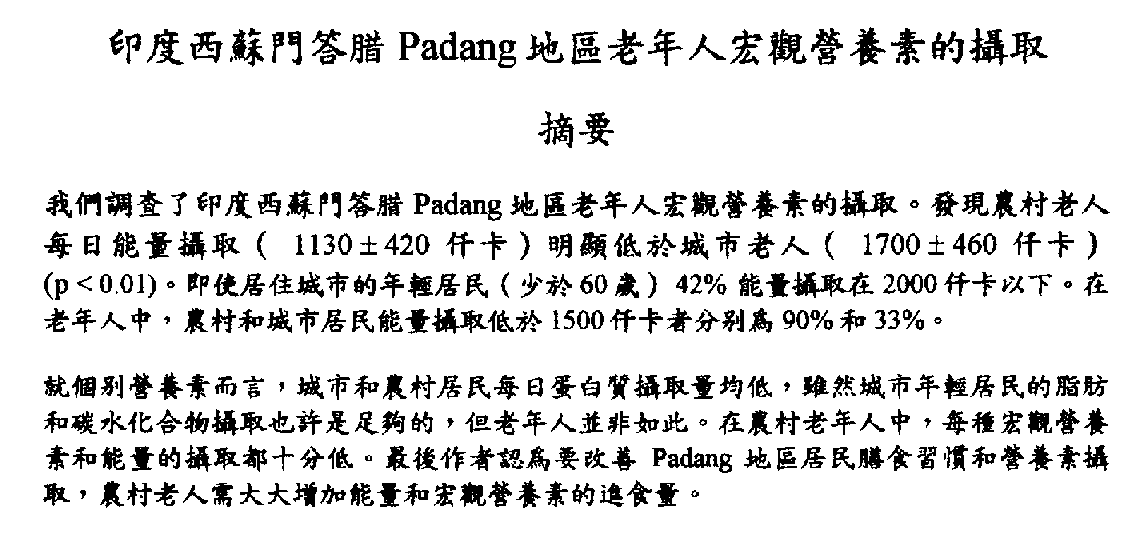

Copyright © 1997 [Asia Pacific Journal of Clinical
Nutrition]. All rights reserved.
to the top
0